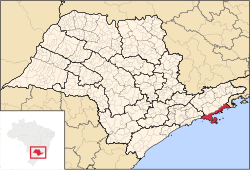Caraguatatuba (micro-region)
| Microregion of Caraguatatuba |
|
|---|---|
| Microregion | |
 Location of Microregion of Caraguatatuba in the state of São Paulo |
|
| Country |
|
| Region | Southeast |
| State |
|
| Mesoregion | Vale do Paraíba Paulista |
| Area | |
| • Total | 1,947.7 km2 (752.0 sq mi) |
| Population (2010 Census) | |
| • Total | 281,532 |
| • Density | 140/km2 (370/sq mi) |
| Time zone | UTC-3 (UTC-3) |
| • Summer (DST) | UTC-2 (UTC-2) |
The Microregion of Caraguatatuba (Portuguese: Microrregião de Caraguatatuba), often referred as Litoral Norte (Northern Coastline), is a microregion in the easternmost coastal part of São Paulo State, Brazil. The microregion is bordered by the state of Rio de Janeiro to the east. It is a famous touristic destination, mainly because of the 160 beaches. According to IBGE, Caraguatatuba Microregion has a GDP of R$2,019,94,.048,00 and a population of 281,532 people spread over an area of 1,947.702 km², which means that the density is 144.5/km². The population increases considerably during the summer, because of the tourists.
The microregion consists of the following municipalities:
The first city to be settled was São Sebastião, in 1636. Ubatuba came next, in 1637, and then Ilhabela in 1805. Caraguatatuba was the last one, in 1857. However, it is important to note that the channel between Ilhabela and São Sebastião had already been sailed by the Portuguese in 1502.
All four cities relied on agriculture and fishing as its main economic activities for most of the 17th, 18th and 19th centuries, whereas São Sebastião served as a major sugar cane, coffea and tobacco production site. In the second half of the 20th century, the cities started to receive several tourists, mostly from São Paulo and nearby cities. This made it possible for the region to make money out of tourism, via hotels, restaurants, handicraft stores and nightclubs.
The Serra do Mar mountain range dominates the landscape of the microregion. Urbanization took place in the plains between the mountains and the sea. The highest point is the Pico de São Sebastião (Saint Sebastian's Peak), in Ilhabela, at 1,378 metres (4,521 ft) above sea level. The oceanic climate sets the temperatures around the region between 20 and 30 °C for most of the year. Rain falls moderately, but it falls more frequently particularly in Ubatuba, which is the reason of the city's nickname Ubachuva (lit. Ubarain).
...
Wikipedia
